Preventable and treatable mortality statistics
Data from March 2024.
Planned article update: April 2025.
Highlights
In 2021, Luxembourg had the lowest death rate in the EU for treatable diseases/conditions (54.7 per 100 000 inhabitants), followed by France, Sweden and the Netherlands. The highest death rates were recorded in Bulgaria and Romania.
In the EU, mortality rates for both treatable and preventable diseases/conditions were higher for males than for females in 2021. This pattern was repeated in all but one of the EU Member States, the Netherlands was the only exception, just for treatable diseases/conditions.
In the EU, 1.8 million persons aged less than 75 years died in 2021; the total number of avoidable deaths among persons aged less than 75 years was 1.3 million.
Among people aged less than 75 years, the three leading causes of avoidable deaths in 2021 in the EU were COVID-19, ischaemic heart diseases and lung cancer.
Standardised death rate for deaths from treatable diseases/conditions among persons aged less than 75 years, by sex, 2021
This article presents statistics for the European Union (EU) on two indicators of avoidable mortality, namely deaths from treatable and preventable diseases/conditions. The concept of treatable and preventable mortality is based on the idea that certain deaths (for specific diseases/conditions defined by the ICD classification – see the Data sources section) could be ‘avoided’ among people aged less than 75 years. In other words, these avoidable deaths would not have occurred at this stage if there had been more effective public health and/or medical interventions in place [1].
- A disease/condition is considered as treatable if a death from this disease/condition could have been avoided through optimal quality health care.
- The concept of preventable deaths covers deaths which could have been avoided by public health interventions focusing on wider determinants of public health, such as behaviour and lifestyle factors, socioeconomic status, and environmental factors.
- The diseases/conditions that can be largely prevented and also treated once they have occurred are attributed to the preventable category.
- In cases when there is no strong evidence of predominance of preventability or treatability diseases/conditions, they are allocated on a 50 % - 50 % basis to the two categories.
This article is one of a set of statistical articles concerning health status in the EU which forms part of an online publication on health statistics.
Full article
Overview
In the EU, 1.8 million persons aged less than 75 years died in 2021. Certain diseases/conditions are treatable and/or preventable. Collectively, deaths that are the result of these diseases/conditions are referred to as avoidable deaths. The total number of avoidable deaths in the EU was 1.3 million in 2021. Among these avoidable deaths, 399 500 could have been avoided with healthcare systems offering timely and effective medical treatments (deaths from treatable diseases/conditions) and 861 700 deaths could have been prevented through better public health interventions (preventable deaths). The leading causes of all avoidable deaths in 2021 were COVID-19, ischaemic heart diseases and lung cancer.
Number and rate of avoidable deaths
In 2021, deaths from avoidable diseases/conditions among people aged less than 75 years amounted to 1.3 million in the EU
A total of 1.3 million deaths in 2021 among people aged less than 75 years – equivalent to a standardised rate of 294.1 deaths per 100 000 inhabitants – could have been avoided in the EU, either through better healthcare systems and/or better public health interventions. A subtotal of 399 500 of these deaths – equivalent to a standardised rate of 93.3 deaths per 100 000 inhabitants – could have been avoided through better healthcare systems (deaths from diseases/conditions that are treatable). The number of preventable deaths was higher than the number of deaths from treatable diseases/conditions due to the broader definition of the former. In 2021, 861 700 deaths in the EU – equivalent to 200.8 deaths per 100 000 inhabitants – could have been prevented through better public health interventions.
Figure 1 shows data for standardised death rates of avoidable mortality, comparing the rates for preventable diseases/conditions with those for treatable ones. These standardised rates assume the same age distribution of the population for all countries.
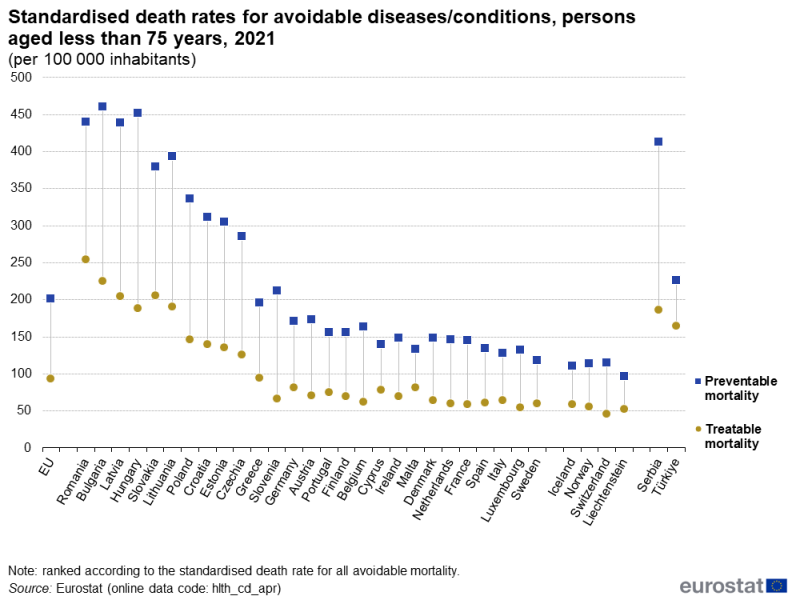
(per 100 000 inhabitants)
Source: Eurostat (hlth_cd_apr)
In all EU Member States, standardised death rates for treatable diseases/conditions were lower than for preventable diseases/conditions.
- The largest absolute gap was in Hungary, where there were 263.5 per 100 000 inhabitants more deaths from preventable than treatable diseases/conditions.
- The narrowest gap was in Malta, where the difference was 51.0 per 100 00 inhabitants.
- The lowest death rate for treatable diseases/conditions in 2021 was recorded in Luxembourg, at 54.7 per 100 000 inhabitants. France, Sweden and the Netherlands also recorded rates under 60.0 per 100 000 inhabitants.
- The highest death rate for treatable diseases/conditions was 254.7 per 100 000 inhabitants in Romania. Bulgaria, Slovakia, Latvia, Lithuania and Hungary all recorded rates above 150.0 per 100 000 inhabitants.
- The lowest death rate for preventable diseases/conditions in 2021 was recorded in Sweden, at 117.8 per 100 000 inhabitants. Italy also recorded a rate under 130.0 per 100 000 inhabitants.
- The highest death rate for preventable diseases/conditions was 460.0 per 100 000 inhabitants in Bulgaria, while Hungary, Romania and Latvia also recorded rates above 400.0 per 100 000 inhabitants.
Avoidable death rates by sex
Mortality rates in the EU were higher for males than for females for avoidable diseases/conditions
In nearly all EU Member States, mortality rates among people aged less than 75 years for treatable diseases/conditions in 2021 were higher for males than for females – see Figure 2.
- The Netherlands was the only Member State to report higher treatable mortality rates for females (61.0 per 100 000 inhabitants) than for males (58.5 per 100 000 inhabitants).
- Among the Member States, the narrowest gender gaps (in relative terms) for treatable diseases/conditions were observed for the Netherlands, Belgium and Italy.
- In relative terms, the largest gender gaps for treatable diseases/conditions were reported for two of the Baltic Member States – Lithuania and Latvia – where the rates for males were 2.1 times as high as the rates for females.
- For males, the Netherlands (58.5 per 100 000 inhabitants) reported the lowest death rate for treatable diseases/conditions in 2021, while Romania (335.5 per 100 000 inhabitants) reported the highest rate.
- For females, the lowest mortality rates for treatable diseases/conditions were reported by Spain and Luxembourg (50.6 and 50.7 per 100 000 inhabitants, respectively) and the highest rates by Bulgaria and Romania (166.8 and 187.0 per 100 000 inhabitants, respectively).
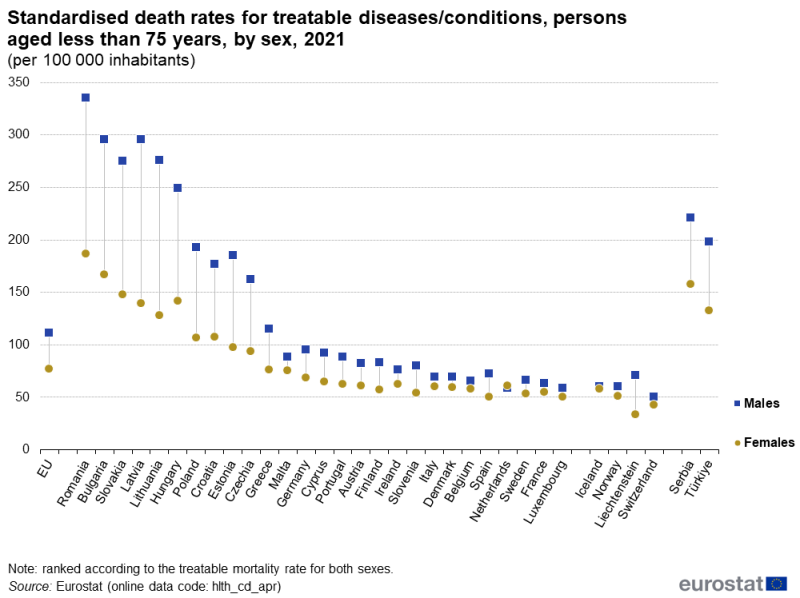
(per 100 000 inhabitants)
Source: Eurostat (hlth_cd_apr)
In all of the EU Member States, preventable mortality rates were higher for males than for females in 2021 – see Figure 3.
- Gender gaps (the difference between the rates for males and for females) were wider for preventable diseases/conditions than for treatable ones.
- Among the Member States, the narrowest gender gap (in relative terms) for preventable diseases/conditions was observed for the Netherlands, with the rate for males 1.7 times as high as the rate for females.
- In 23 of the Member States, the death rate for preventable diseases/conditions for males was more than double the rate for females. In five of the Member States, the rate for males was at least 3.0 times as high as the rate for females. The widest gender gap was recorded in Portugal, with the rate for males 3.3 times as high as the rate for females.
- For males, Sweden (153.5 per 100 000 inhabitants) reported the lowest death rate among the Member States for preventable diseases/conditions in 2021. Latvia (705.0 per 100 000 inhabitants) reported the highest rate.
- For females, the lowest mortality rate for preventable diseases/conditions was reported by Spain (67.9 per 100 000 inhabitants) and the highest rates by Romania (267.0 per 100 000 inhabitants), Hungary (282.1 per 100 000 inhabitants) and Bulgaria (297.5 per 100 000 inhabitants).
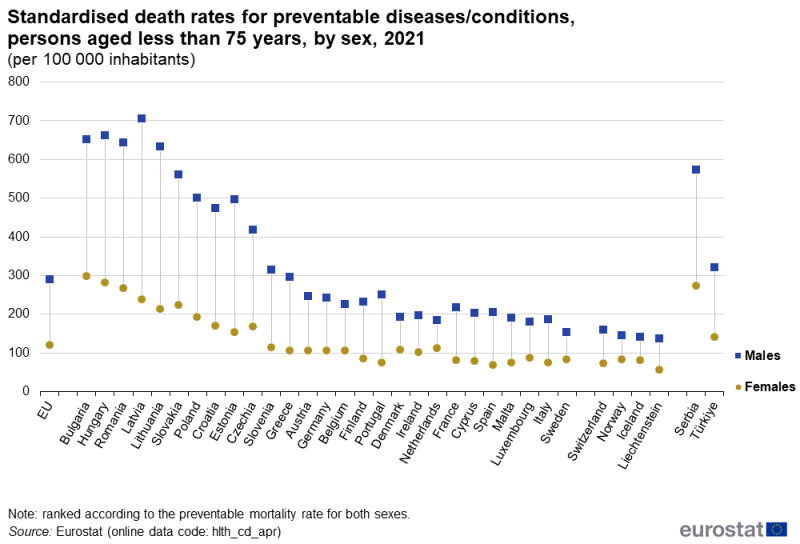
(per 100 000 inhabitants)
Source: Eurostat (hlth_cd_apr)
Leading causes of avoidable deaths
By far the most common causes of avoidable deaths in the EU were COVID-19 (207 200 deaths), ischaemic heart diseases (165 200 deaths) and lung cancer (137 300 deaths). The second of these is split between treatable and preventable diseases, while the other two are preventable.
Table 1 lists the main avoidable diseases/conditions in terms of their number of deaths in 2021. The 12 individual diseases/conditions that are listed collectively accounted for 73.9 % of the total number of deaths from avoidable diseases/conditions. They accounted for 65.1 % of deaths from treatable diseases/conditions and 78.0 % of preventable deaths. The largest numbers of deaths from purely treatable diseases/conditions were 57 600 from colorectal cancer and 41 800 from breast cancer (females only).
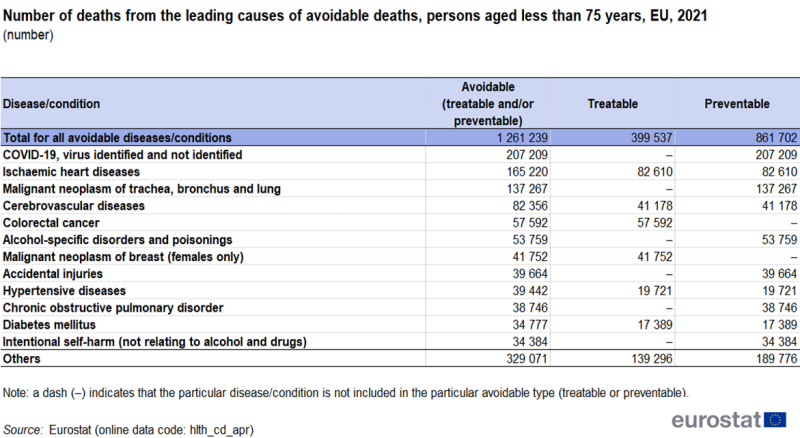
(number)
Source: Eurostat (hlth_cd_apr)
The leading cause of death for treatable diseases/conditions was COVID-19
Figure 4 shows the leading causes of death in the EU for avoidable diseases/conditions in 2021.
The EU standardised rate of deaths from treatable diseases/conditions from ischaemic heart diseases was 19.1 per 100 000 inhabitants, equivalent to 20.5 % of the total number of deaths from treatable diseases/conditions. Colorectal cancer (13.4 per 100 000 inhabitants), breast cancer among females only (9.7 per 100 000 inhabitants) and cerebrovascular diseases (9.6 per 100 000 inhabitants) were the next most common causes of death among treatable diseases/conditions. Collectively, the seven treatable diseases/conditions shown in Figure 4 accounted for almost three-quarters (72.4 %) of all deaths from treatable diseases/conditions in 2021.
The leading causes of preventable deaths were COVID-19, lung cancer, ischaemic heart diseases and alcohol-specific disorders and poisonings
The EU standardised rate of preventable deaths for COVID-19 was 48.1 per 100 000 inhabitants in 2021, equivalent to 24.0 % of the total number of preventable deaths. Lung cancer (31.7 per 100 000 inhabitants), ischaemic heart diseases (19.1 per 100 000 inhabitants) and alcohol-specific disorders and poisonings (12.6 per 100 000 inhabitants) were the next most common causes of preventable deaths. The seven preventable diseases/conditions shown in Figure 4 collectively accounted for more than two-thirds (69.4 %) of all preventable deaths in 2021.
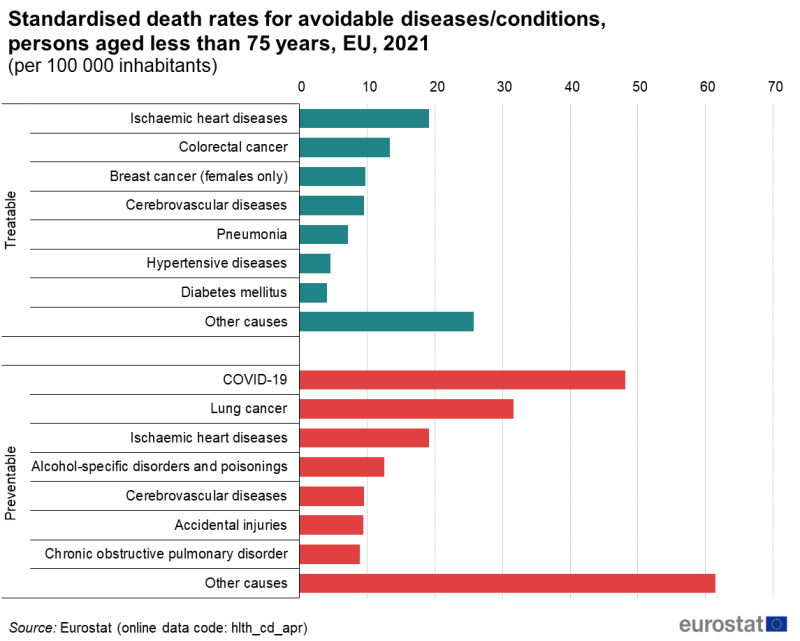
(per 100 000 inhabitants)
Source: Eurostat (hlth_cd_apr)
Leading causes of avoidable death – analysis by sex
With the exceptions of some types of cancer that are exclusively or almost exclusively found among females, the leading causes of death from treatable diseases/conditions were broadly similar for males and females
The distribution of treatable diseases/conditions in the EU varies somewhat for males and females, reflecting the fact that some of the major causes of death are sex-specific to a large or even exclusive extent.
- Among females, the leading cause of death from treatable diseases/conditions was breast cancer: this disease alone was responsible for close to one-quarter (24.3 %) of all deaths from treatable diseases/conditions among females, reflecting a standardised death rate of 18.7 per 100 000 female inhabitants. Cancer of the uterus (3.7 per 100 000 female inhabitants) was also among the top causes of death shown in Figure 5 and is sex specific.
- For diseases common to males and females, the most frequent cause of death for treatable diseases/conditions in the EU was ischaemic heart diseases (30.1 per 100 000 male inhabitants and 9.2 per 100 000 female inhabitants) and colorectal cancer (17.5 per 100 000 male inhabitants and 9.7 per 100 000 female inhabitants).
- The greatest difference between sexes was observed for ischeamic heart disease which had a standardised death rate that was over three times higher in males than females. The smallest difference was observed for certain conditions originating in the perinatal period (2.2 per 100 000 male inhabitants and 1.8 per 100 000 female inhabitants).
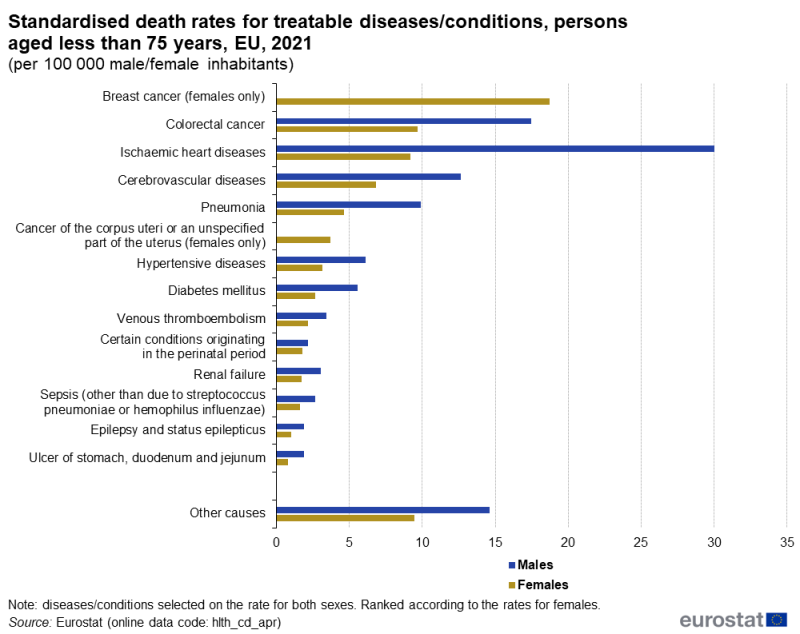
(per 100 000 male/female inhabitants)
Source: Eurostat (hlth_cd_apr)
For preventable deaths, the three leading causes of death in the EU were the same for males and for females: COVID-19, lung cancer and ischaemic heart diseases. Standardised death rates were higher among males than among females for all of the conditions/diseases presented in Figure 6. The greatest difference between sexes was observed for lip, oral cavity and pharynx cancer, which was 4.3 times higher in males than females (7.3 per 100 000 male inhabitants and 1.7 per 100 000 female inhabitants). Rates in males were also over 4 times higher for transport accidents (7.3 per 100 000 male inhabitants and 1.7 per 100 000 female inhabitants) and intentional self-harm (13.5 per 100 000 male inhabitants and 3.3 per 100 000 female inhabitants).
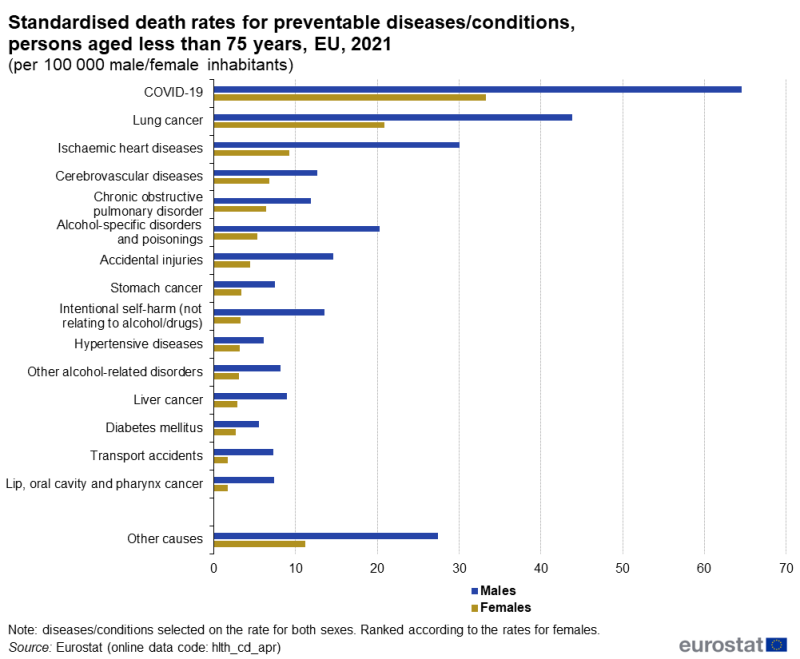
(per 100 000 male/female inhabitants)
Source: Eurostat (hlth_cd_apr)
Leading causes of avoidable death – analysis by EU Member State
In 2021, the five most common causes of death in the EU from treatable diseases/conditions accounted for 63.2 % of all such deaths. These five causes (as well as a residual category for all other causes) are presented in Figure 7. The share of these five common causes ranged among the EU Member States from 53.5 % in Estonia to 74.8 % in Slovakia.
Among these five leading causes of death across the EU in 2021 from treatable diseases/conditions, ischaemic heart disease had the highest standardised death rate in 19 of the EU Member States. In six others – Portugal, Spain, Denmark, the Netherlands, Italy and France – the highest rate was observed for colorectal cancer. In Luxembourg, the highest rate was for breast cancer, while in Bulgaria the highest rate was for cerebrovascular diseases.

(per 100 000 inhabitants)
Source: Eurostat (hlth_cd_apr)
The five most common causes of preventable death in the EU in 2021 accounted for 60.3 % of all such deaths. These are presented in Figure 8. The share of these five common causes ranged among the EU Member States from 49.0 % in Denmark to 74.8 % in Bulgaria.
Among these five leading causes of preventable deaths in the EU in 2021, COVID-19 had the highest standardised death rate in 15 of the EU Member States. In 10 others, the highest rate was observed for lung cancer. In Estonia and Finland, the highest rate was for alcohol-specific disorders and poisonings.
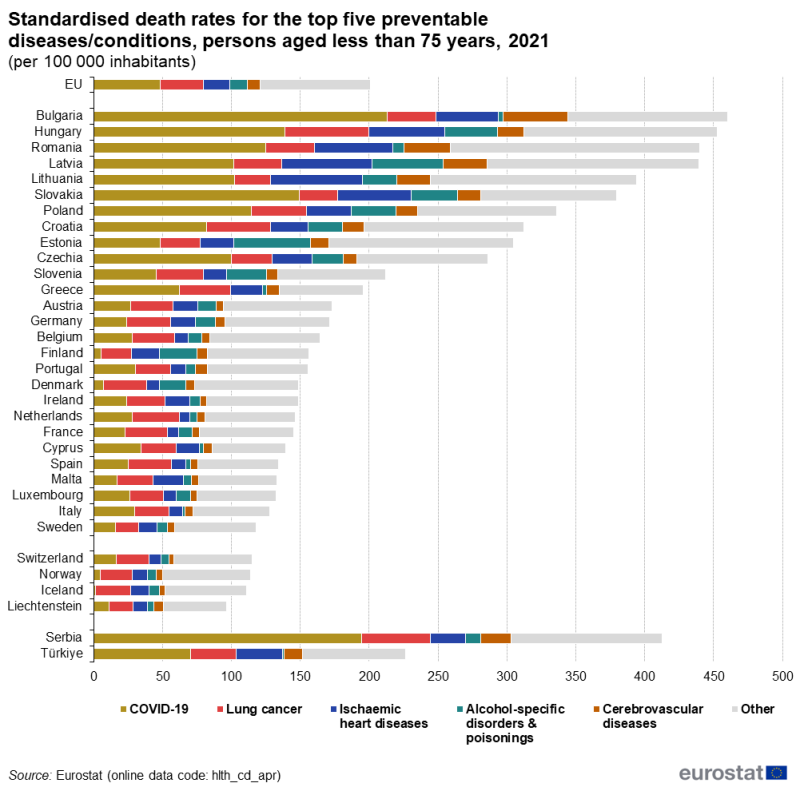
(per 100 000 inhabitants)
Source: Eurostat (hlth_cd_apr)
Source data for tables and graphs
Data sources
The definitions of avoidable deaths are based on the following:
- a disease/condition leading to a death is treatable if, in the light of medical knowledge and technology at the time of death, all or most deaths from that cause could be avoided through optimal quality health care;
- a disease/condition leading to a preventable death is one which, in the light of understanding of the determinants of health at the time of death, all or most deaths from that cause could be avoided by public health interventions in the broadest sense.
To calculate treatable and preventable mortality, the first step is to define which diseases/conditions cause deaths that could – potentially – have been avoided through optimal quality health care (deaths from treatable diseases/conditions) and through public health interventions (preventable deaths). In 2018, the OECD and Eurostat worked together with an expert group to develop new lists of treatable and preventable causes of mortality. These lists built on earlier work carried out by researchers (such as Nolte E. and M. McKee (2004 and 2011)), by some OECD countries and by Eurostat. The new OECD-Eurostat lists were approved during the OECD Working Party on Health Statistics in October 2018 and during the Eurostat Working Group on Public Health Statistics in December 2018. The list was slightly revised in November 2019. The complete list of diseases/conditions considered to cause avoidable deaths can be found here. The age up to which a death can be considered avoidable is set at 74 years (inclusive) to reflect life expectancy. The list of diseases/conditions and the age limit reflect current health expectations, medical technology and knowledge, and developments in healthcare public policy. As such, they are subject to change. For example, the data for 2020 and 2021 include COVID-19 as a preventable disease.
The second step in the calculation of treatable and preventable deaths is the summation of all deaths within the age limit where the underlying cause of death was included in the list of diseases/conditions for avoidable deaths. The underlying statistics used to calculate avoidable mortality indicators are causes of death data; these include detailed information on the underlying cause of death of the deceased. More information on the methodology used for statistics on the causes of death is available in a background article. The data for causes of death are included in an annual data collection with a legal basis requiring all EU Member States to send complete data to Eurostat.
Note that some diseases/conditions are considered to be treatable and preventable. An example is ischaemic heart diseases, from which a death might be successfully avoided through timely and effective health care (for example through thrombolytic therapy) and/or through effective public health intervention to reduce the underlying risk factors (for example reduced salt intake).
The causes of death that can be both largely prevented and also treated once they have occurred are attributed to the preventable category on the rationale that if these diseases/conditions are prevented, there would be no need for treatment. The number of deaths for a specific disease/condition are generally not fractioned as being partly preventable and partly treatable given the lack of evidence to do this accurately and systematically. An exception is when there is no strong evidence of predominance, in which case a 50 %-50 % allocation is used. As such, any double counting of the same death between the two lists is avoided and therefore the number of deaths according to the two lists can be aggregated to provide a broad assessment of the relative importance of prevention and healthcare interventions in reducing the number of avoidable deaths.
Annual data on the two types of avoidable deaths are provided in absolute numbers and as standardised death rates. Since most causes of death vary significantly by age and according to sex, the use of standardised death rates improves comparability over time and between countries as death rates can be measured independently of a population’s age structure: standardised death rates are calculated based on the European Standard Population. Note that the standardised death rates used in this article are calculated per 100 000 inhabitants aged less than 75 years.
Context
Assessing the performance of healthcare systems is of increasing importance in the EU. While avoidable mortality indicators are not meant to be a definitive measure of the quality of the health care in EU Member States, they provide some indication of the quality and performance of health care and of (wider) public health policies. In addition to health care and public health policies, other factors related to the likelihood that individuals may contract a disease or seek medical advice – such as education, social background, health beliefs, levels of concern, costs of diagnosis and treatment – are likely to influence the number of avoidable deaths [2]. Improvements in health policies should translate into lower numbers of avoidable deaths. However, there is likely to be a long time lag between implementation of health (care) policies and changes in mortality rates and therefore any conclusions need to be drawn with caution.
Notes
- ↑ See the discussions in Nolte E. and M. McKee (2004): Does Health Care Save Lives? Avoidable Mortality Revisited, Nuffield Trust, London; and Gay J. et al. (2011): Mortality Amenable to Health Care in 31 OECD Countries, OECD Health Working Papers No. 55, OECD.
- ↑ See page 18 of Nolte E. and M. McKee (2004), Does Health Care Save Lives? Avoidable Mortality Revisited, Nuffield Trust, London.
Direct access to
- Causes of death (hlth_cdeath)
- Public health themes (hlth_cd_pbt)
- Treatable and preventable mortality of residents by cause and sex (hlth_cd_apr)
- Public health themes (hlth_cd_pbt)